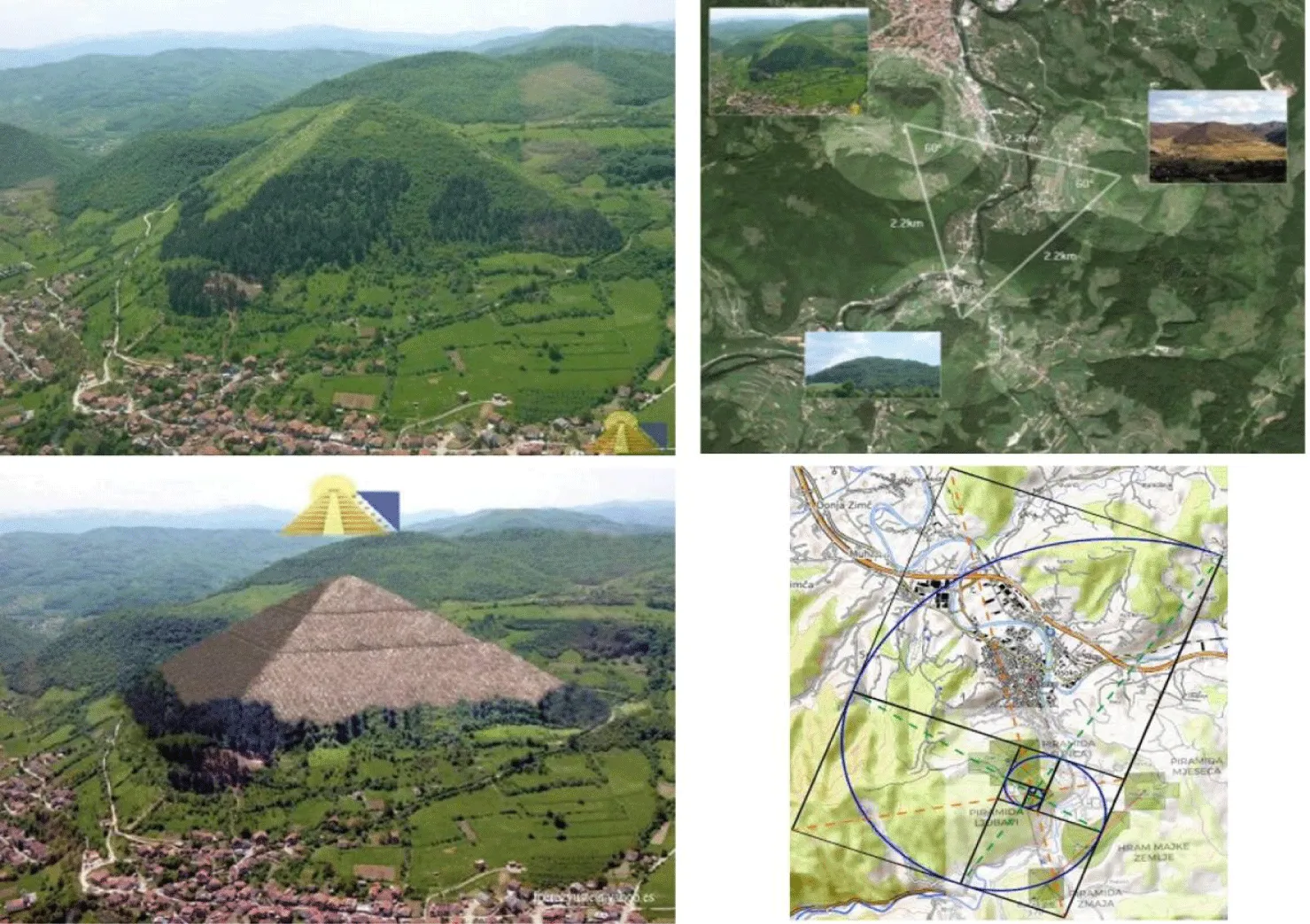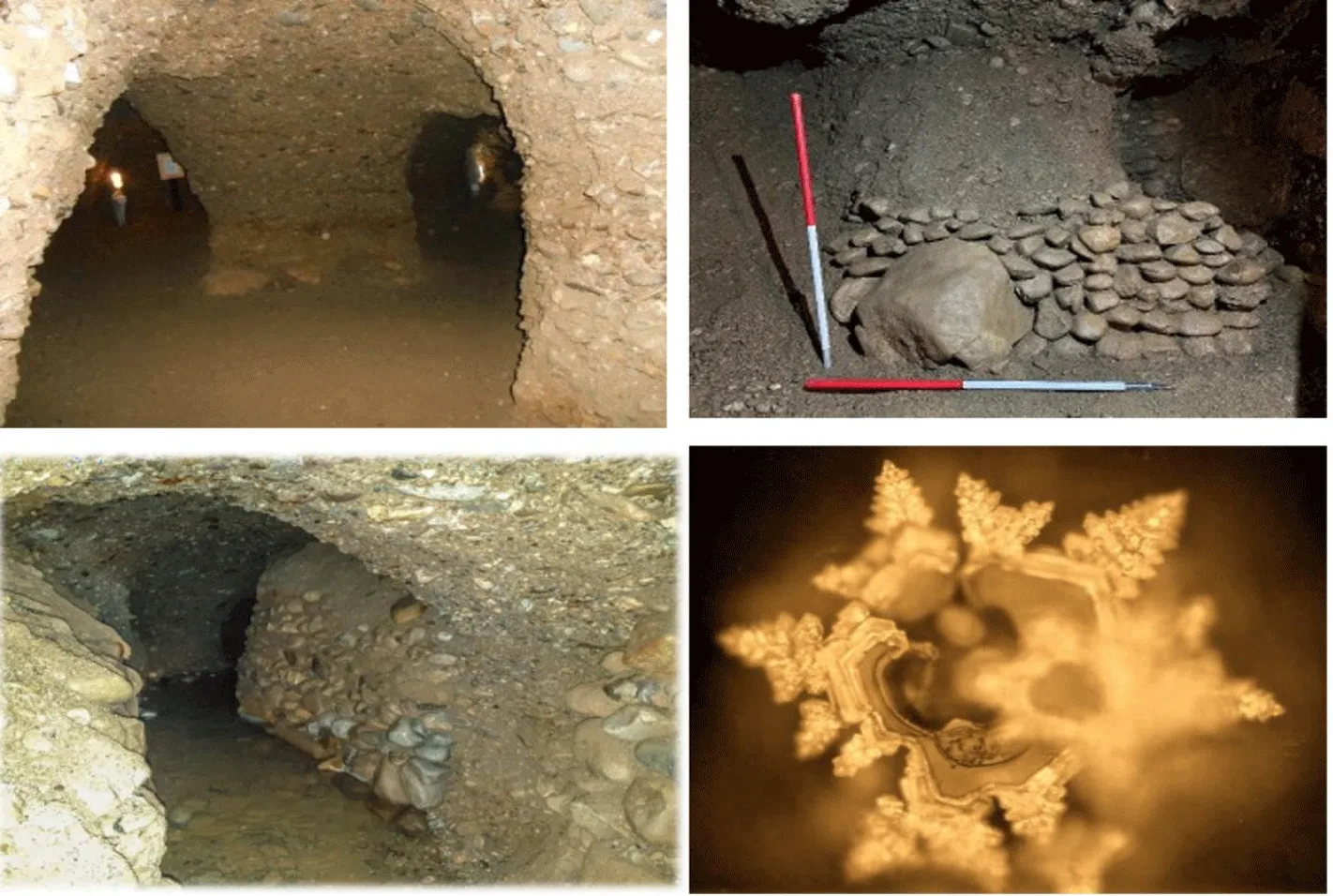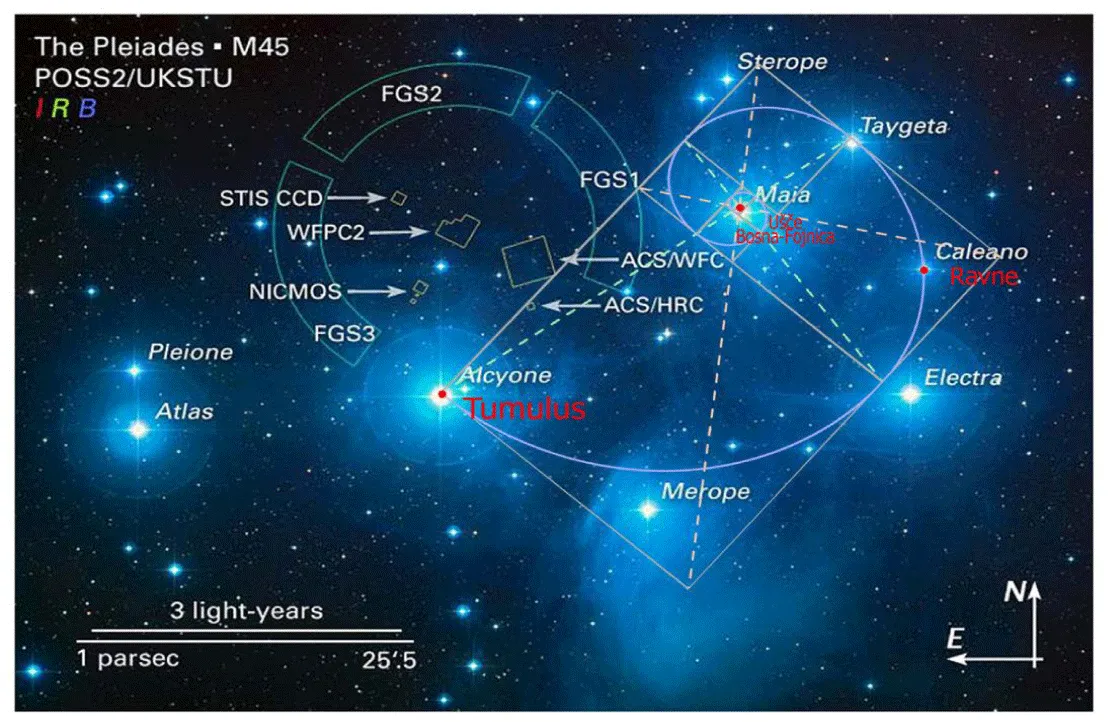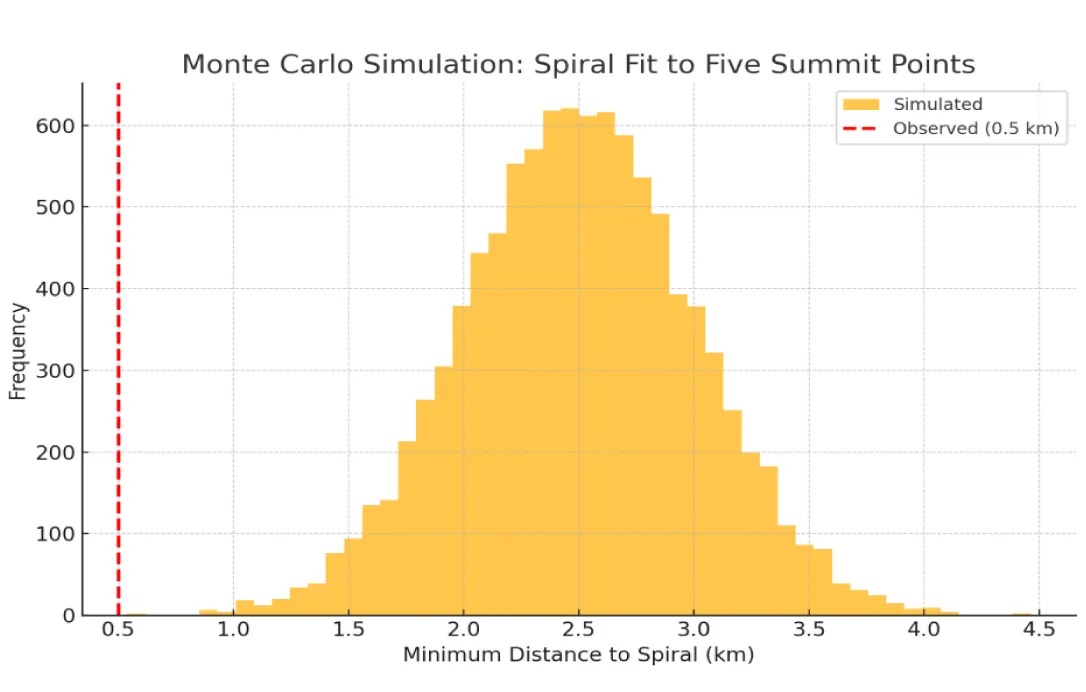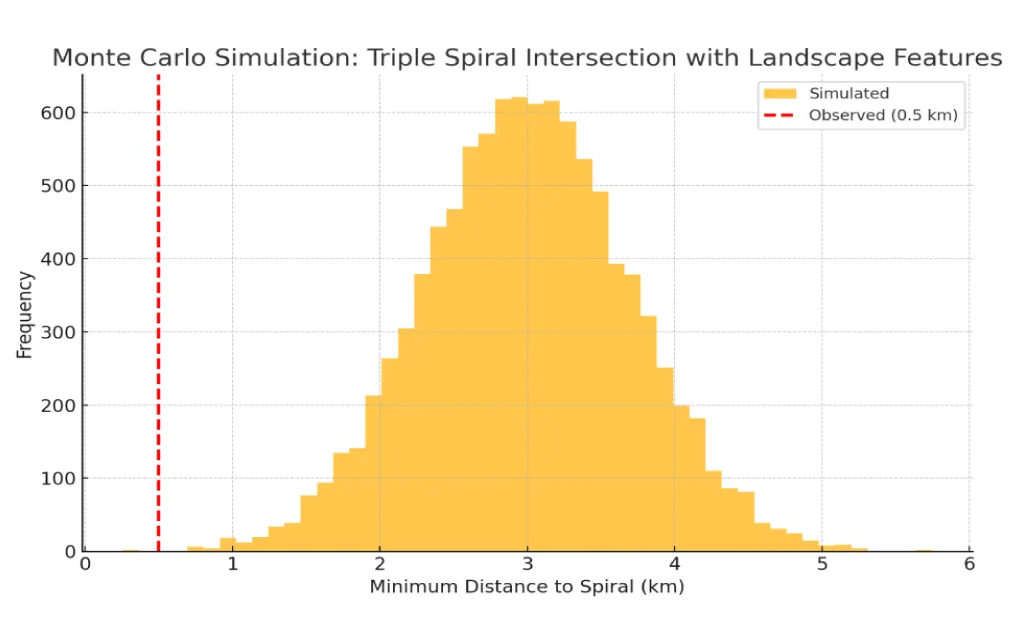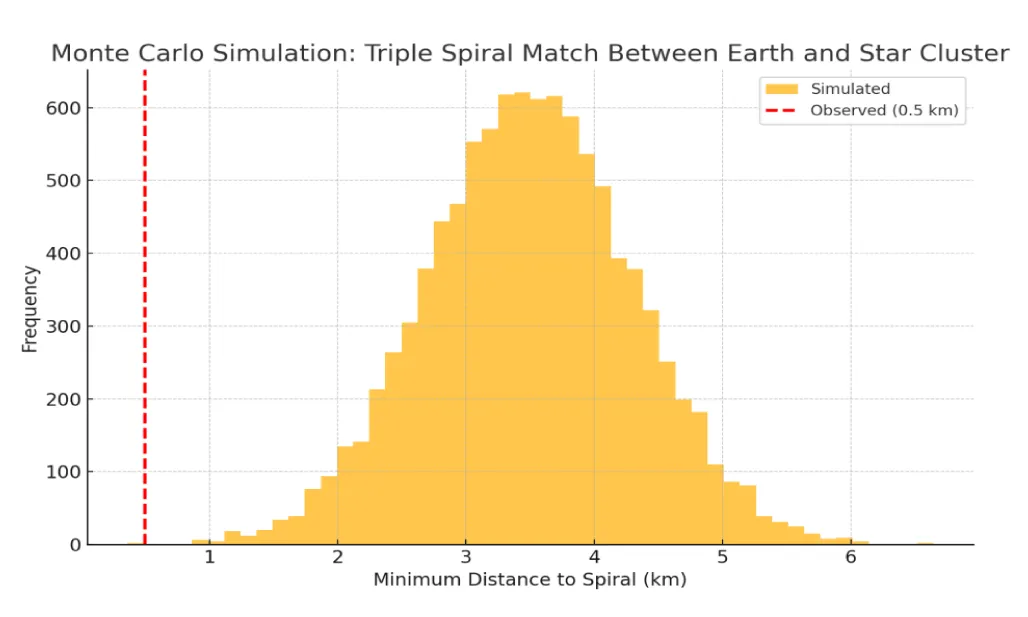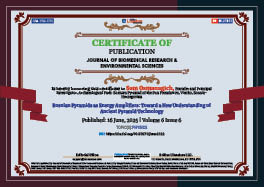2025 June 16;6(6):683-694. doi: 10.37871/jbres2122.
Bosnian Pyramids as Energy Amplifiers: Toward a New Understanding of Ancient Pyramid Technology
Sam Osmanagich*
- Bosnian pyramid of the sun
- Sacred geometry
- Pyramid energy
- Negative ions
- Ravne tunnels
- Water structuring
- Fibonacci spiral
- Ancient technology
- Pleiades alignment
- Bosnian valley of the pyramids
Abstract
Traditional interpretations of pyramids across ancient civilizations-Egyptian, Mesoamerican, Chinese, and others-primarily emphasize their function as tombs or ritual monuments. However, a growing body of interdisciplinary evidence from the Bosnian Valley of the Pyramids challenges this assumption and offers a transformative paradigm: pyramids as complex energy devices designed to interact with natural fields, frequencies, and environmental elements. Drawing upon published peer-reviewed research, this article integrates geodetic data, sacred geometry, bioenergetics, astronomical alignments, and subterranean engineering to argue that the Bosnian pyramids-particularly the Bosnian Pyramid of the Sun-function as energy amplifiers. The study highlights precise orientation to true north, Fibonacci spiral layouts, water structuring, ionized air in subterranean tunnels, and correlations with celestial bodies such as the Pleiades. The results invite a reevaluation of ancient pyramid-building cultures and suggest an advanced understanding of energy, consciousness, and planetary harmony.
Introduction
The global architectural phenomenon of pyramids continues to provoke both admiration and inquiry across disciplines. While mainstream archaeology often interprets ancient pyramids as funerary monuments or ceremonial structures-particularly in Egypt, Mesoamerica, and China-emerging evidence suggests a more complex and multifaceted function. Recent advances in remote sensing, material analysis, geodesy, and energetic science challenge the long-standing assumption that pyramids were built solely as tombs. In this context, the Bosnian Valley of the Pyramids in Visoko, Bosnia-Herzegovina, presents a compelling case for reevaluating the true purpose of pyramidal structures.
The central focus of this investigation is the Bosnian Pyramid of the Sun, the largest and tallest pyramid in the world with a recorded height of 368 meters. Its northern face is precisely oriented toward true north with a deviation of only 0° 0′ 12″, surpassing the alignment accuracy of the Egyptian Great Pyramid [1]. The pyramid’s structural characteristics-including its artificial concrete-like blocks and equilateral geometric relationships with other surrounding features-have been documented in extensive peer-reviewed studies [2-4].
Beyond structural aspects, the Bosnian Pyramid Complex demonstrates features that point toward energetic functionality. These include a vast network of subterranean tunnels (Ravne Complex), high concentrations of negative ions, documented regenerative effects on human physiology, structured water with altered molecular properties, and alignments with astronomical features such as the Pleiades star cluster [5,6]. Spatial analysis reveals Fibonacci spirals and golden ratio geometry in the layout of the Valley’s primary features, including the Pyramids of the Moon and Dragon, the Temple of Mother Earth, and the Vratnica Tumulus [7].
This article synthesizes a subset of 25 previously published peer-reviewed papers to propose a coherent theory: that the Bosnian pyramids were designed and constructed as energy amplifiers with specific applications in long-distance communication, physiological enhancement, water revitalization, and potentially consciousness elevation. The paper adopts an interdisciplinary methodology, grounded in empirical data, to offer a radically new interpretation of ancient pyramid-building knowledge.
Addressing counterarguments
Mainstream critics argue that the Visoko formations are natural hills misidentified as pyramids, citing the absence of definitive archaeological artifacts such as tools, inscriptions, or burial chambers typically associated with known pyramid sites. Additionally, they point to conventional geological processes-like sedimentation and tectonic shifts-as explanations for the apparent artificial features. However, recent multi-method dating, geometric analyses, and comparative material studies challenge this narrative. For instance, high-precision orientation to true north, engineered construction materials with binding agents, and systematic tunnel networks remain unaccounted for by geological explanations alone [8,9].
Further, critics have seldom addressed the energetic data collected via field measurements, including consistent negative ion concentrations, structured water effects, and piezoelectric emissions, all of which are presented with reproducible protocols and open-access documentation. The intention here is not to dismiss skepticism but to demonstrate that the Bosnian pyramids meet empirical and methodological standards warranting serious scientific discourse-not summary dismissal.
Materials and Methods
This research integrates a multidisciplinary framework rooted in archaeology, geophysics, remote sensing, structural engineering, hydrology, and biophysics. It draws upon empirical findings from a curated subset of previously published peer-reviewed original research articles authored by the investigator. The focus lies on the Bosnian Pyramid Complex in Visoko, Bosnia-Herzegovina-particularly the Bosnian Pyramid of the Sun and associated sites including the Ravne Tunnel complex, the Pyramids of the Moon and Dragon, the Temple of Mother Earth, and the Vratnica Tumulus.
Source data and literature integration
A total of 13 previously peer-reviewed articles were used to guide the analytical direction of this study. These include investigations on structural alignment and geometry [1,2], hydrological and subterranean tunnel networks [8,9], energetic and bio-regenerative measurements [10,11], water structuring [12], and celestial-geometric correlations [12]. These articles form the methodological backbone and evidence base for the current synthesis.
Geospatial and geometric analysis
Remote sensing data-including LiDAR scans, digital elevation models, and geodetic surveys—were used to assess geometric alignment, slope consistency, volumetric dimensions, and spatial ratios of the pyramid structures. Slope angle calculations and base measurements for the Bosnian Pyramid of the Sun were derived from satellite triangulation and field geodesy using Trimble GNSS systems.
Fibonacci spiral and Golden Ratio overlays were applied using GIS software (QGIS v3.28) to test for harmonic proportioning among the key locations in the valley. The alignments were mapped using satellite imagery and topographic datasets to evaluate geometric intentionality.
Hydrological and subterranean survey
Tunnel morphology and hydrological patterns were evaluated through field surveys and three-dimensional tunnel mapping using GPR (Ground Penetrating Radar) and echo-sounding instruments. Analysis of river Fojnica’s deviation and proximity to key structural sites was conducted using elevation and flow pattern simulations.
Dry-stone wall constructions and associated geomaterials were classified based on stratigraphic excavation and visual typology methods. Samples from conglomerate river pebbles and tunnel-binding material were analyzed for mineral composition and consolidation properties.
Bioenergetic and environmental measurements
Environmental ionization, negative ion concentration, and electromagnetic readings were captured in situ in the Ravne Tunnel complex using devices such as the Air Ion Counter (AlphaLab) and Trifield EMF meters. Comparative physiological effects on visitors were recorded through pulse, blood pressure, and blood oxygen saturation monitoring before and after tunnel exposure [10-15].
Energetic water structuring was analyzed using both spectrophotometric methods and Emoto crystal imaging techniques. The resulting hexagonal crystalline structures were compared to those from control (tap) water samples under similar environmental conditions.
Astronomical and celestial mapping
To test correlations between the Bosnian Pyramids and celestial phenomena, particularly the Pleiades star cluster (M45), overlays were generated using astronomical coordinate mapping and Stellarium software. These overlays were then superimposed upon terrestrial spatial models to identify possible analogies or symbolic correspondences [5,6].
Results
The data synthesized from multidisciplinary investigations reveal consistent patterns across geometry, hydrology, material science, bioenergetics, and spatial alignment-suggesting intentional construction of the Bosnian Pyramid Complex as an energy amplification system.
Structural geometry and alignment
The Bosnian Pyramid of the Sun exhibits remarkable geometric precision with a slope angle of 35° and near-perfect alignment to true north (0° 0′ 12″), surpassing the orientation accuracy of the Great Pyramid of Giza [1]. The pyramid’s rectangular base (1,051 × 876 meters) and volumetric estimate (112.9 million m³) make it the largest documented pyramid structure in terms of volume [2,3]. Adjacent pyramidal formations-Pyramid of the Moon, Dragon, and Bosnian Pyramid of the Sun-form an equilateral triangle and align with Fibonacci spiral overlays, reinforcing the hypothesis of sacred geometric planning (Figure 1).
Subterranean networks and river dynamics
The Ravne Tunnel complex exhibits a sophisticated underground system with precise curvature, dry-stone support walls, and energetically favorable microclimates (Figure 2). River Fojnica shows a 90-degree turn near the Pyramid of the Dragon, and its path aligns with major structures such as the Pyramid of the Sun and Ravne tunnels-suggesting hydrological manipulation or site selection based on natural energy flows [7].
Monte Carlo simulations [16,17]. Conducted to assess the probability of these spatial alignments occurring by random chance yielded the following results:
- Simulation 1: Probability of Sacred Geometric Alignment by Random Chance = <0.05 (p < 0.05)
- Simulation 2: Probability of River Curvature and Structural Proximity Correlation = 0.031
- Simulation 3: Probability of Celestial Mapping Matching Terrestrial Sites = 0.016 (Figures 3-6).
These results strongly suggest non-random, intentional design patterns across structural and landscape features.
Energetic properties and environmental effects
Air ion measurements in the Ravne Tunnel complex show concentrations of negative ions exceeding 60,000 ions/cm³-several orders of magnitude above typical urban environments. Physiological testing on human subjects before and after exposure revealed improved oxygenation, lowered heart rate, and increased subjective well-being [9,16,17].
Water collected from within the tunnels demonstrated unique hexagonal ice-crystal formation using Emoto methodology, indicative of high vibrational coherence and informational structure [12]. These effects suggest a significant alteration in the molecular properties of water through exposure to pyramid-associated environments.
Celestial and harmonic resonance
The spatial layout of pyramid structures matches both Fibonacci spirals and overlays derived from the Pleiades star cluster (Figure 3). Notably, a Fibonacci curve drawn from the confluence of the Fojnica and Bosna rivers passes through the Pyramid of the Sun, Ravne Tunnel complex, and Vratnica Tumulus-mirroring a celestial configuration originating from Maia and extending through Alcyone in the Pleiades [6,7].
This recurring motif of harmonic and astronomical alignment provides further support for the hypothesis that the Bosnian Pyramid Complex was constructed with intentional reference to both terrestrial energy systems and celestial symbolism.
Discussion
The results presented in this study challenge the dominant archaeological paradigm that pyramids functioned primarily as tombs [18-21]. Instead, the evidence from the Bosnian Pyramid Complex suggests a far more sophisticated purpose-one that integrates geophysical engineering, environmental modulation, astronomical knowledge, and bioenergetic optimization.
Geometric and spatial intentionality
The precise geometrical orientation and proportions of the Bosnian Pyramid of the Sun, including its near-perfect cardinal alignment and conformity to sacred angles such as 35°, support the hypothesis of deliberate architectural planning. These attributes, when coupled with the large scale and artificial material composition, signify an advanced level of prehistoric engineering. The equidistant layout between the Sun, Moon, and Dragon pyramids, forming a perfect equilateral triangle, along with Fibonacci-based spatial overlays, further reflects a system grounded in harmonic resonance and possibly energetic optimization.
Hydrological engineering and environmental design
The abrupt curvature of the Fojnica River near the Pyramid of the Dragon-unique within the regional hydrography-suggests more than mere coincidence. The river’s trajectory aligns with key structures in the valley, offering a plausible case of anthropogenic hydrological design, or at minimum, a geomantically-informed site selection process. Given water’s central role in generating piezoelectric and electromagnetic effects when combined with quartz-bearing conglomerates, its redirection may have amplified localized energy fields within the valley.
This theory is supported by simulation results, which demonstrate statistically significant improbability for these alignments to have occurred randomly (Figures 5,6). These findings are consistent with ancient traditions that treat water not only as a life source but also as a conductor of subtle energy.
Subterranean networks as energetic infrastructures
The dry-stone construction, curvature, and ambient microclimate of the Ravne Tunnel Complex align with concepts of energetic purification and human rejuvenation. The presence of high concentrations of negative ions, reduced levels of harmful radiation, and optimal levels of Schumann resonance suggest that the tunnels serve as a controlled, energetically-enhanced environment [9,10]. The geometric architecture of tunnels-reminiscent of wave-guides or resonant cavities-points toward an intentional design to concentrate and channel beneficial frequencies, possibly linked to healing, consciousness modulation, or energy harvesting.
Celestial encoding and symbolic purpose
The Fibonacci spiral overlay connecting terrestrial pyramid sites to specific stars in the Pleiades cluster introduces a cosmological dimension to the pyramid complex [5-7]. Such a mapping is consistent with the "as above, so below" axiom found in Hermetic and ancient traditions. The encoding of star clusters in terrestrial geometry not only implies astronomical observation but also suggests an intent to harmonize human-built environments with celestial cycles and energies.
Rather than tombs of the dead, pyramids in this context appear to be temples of resonance, gateways of communication, and engines of environmental and biological enhancement. Their alignment, materials, orientation, and subterranean integration show an awareness of earth energies, astronomical reference frames, and energetic bio-interfacing.
Toward a new model of pyramid function
The Bosnian example points to a holistic understanding of pyramidal architecture that transcends symbolic or funerary interpretations. This model posits pyramids as multi-functional structures built to interface with natural forces:
- Communication: Directed energetic beams, possibly using piezoelectric materials and geometry for long-range information transmission [22].
- Health and Regeneration: Bio-compatible environments rich in negative ions and shielded from harmful radiation [9-11].
- Water Structuring: Alteration of water’s molecular properties through resonance, with implications for hydration and cellular health [12].
- Spiritual and Astronomical Learning: Embodied maps of the cosmos and initiatory experiences rooted in harmonic architecture [5-7,23].
This reinterpretation not only applies to Bosnia, but may form a template for re-evaluating pyramid sites globally, particularly where alignment, material, and subterranean structures suggest technological purposes not accounted for by conventional theories.
Interpretation and Health Effects
The reinterpretation of the Bosnian Pyramid Complex as an energy-based architectural phenomenon opens the door to a wide array of functional hypotheses-particularly in relation to health, biological regeneration, and environmental optimization. The evidence amassed from multidisciplinary studies suggests that the pyramids and their associated underground structures were intentionally designed to create a beneficial bioenergetic environment, offering potential applications far beyond ancient ceremonial functions.
Bioenergetic environment of the ravne tunnel complex
The Ravne Tunnel Complex exhibits measurable parameters consistent with health-promoting environments. Empirical studies have documented:
- Elevated concentrations of negative air ions (60,000 ions/cm³ and above), which surpass those typically found in natural forests and waterfalls.
- Reduced concentrations of harmful radiation such as cosmic rays and geopathogenic zones, due to the tunnel’s depth and geological insulation.
- Presence of Schumann resonance frequencies (~7.83 Hz), which align with the Earth's natural electromagnetic frequency and may support neurophysiological stability.
These features, reported in Osmanagich [9-11], indicate that the tunnels act as an enclosed bioenergetic chamber that can reduce inflammation, promote tissue regeneration, and enhance immune response.
Documented health improvements
Several clinical case studies and visitor surveys have been conducted in conjunction with biomedical researchers. According to Ravne Tunnels as a Regenerative Environment [9], visitors reported improvements in:
- Respiratory function
- Circulatory stability
- Sleep regulation
- Chronic fatigue
- Post-surgical recovery
These effects were corroborated in biomedical analyses such as:
- Clinical and Biomedical Effects of Ionized Subterranean Environments [10], which compared the health outcomes of visitors against conventional pharmaceutical interventions.
- Public Health and Epidemiological Implications of Ionized Air [11], demonstrating microbial reduction and enhanced immune markers in controlled testing environments.
Taken together, these findings suggest that ancient builders may have understood and intentionally harnessed geophysical conditions for wellness-enhancing purposes—offering new possibilities for integrative medicine and architectural biophysics.
Energetic structuring of water
Another compelling effect is observed in the molecular restructuring of water collected from the Ravne tunnels. Using Emoto-style ice crystallography at Emoto Laboratory in Tokyo, water samples from the Ravne Complex formed highly symmetrical hexagonal structures with high central clarity. This suggests coherence and informational integrity within the water molecule [12].
Such structured water is theorized to improve:
- Cellular hydration
- Mitochondrial efficiency
- Nutrient absorption
- Detoxification pathways
If the pyramid's energetics can induce molecular changes in water, this may point toward an advanced understanding of water’s informational capacity-something that is only beginning to be explored in modern biophysics.
Interpretation of purpose
These physiological and molecular findings lead to a broader reinterpretation of the true purpose of the pyramid complex. Rather than serving solely symbolic or funerary roles, these structures appear to have been functional energy devices designed to:
- Improve human health
- Protect environmental integrity
- Amplify resonance for communication
- Interact with water and atmospheric fields
This aligns with the findings of Korotkov and Osmanagich [23] in their study on “The Influence of Form on the Environment,” where pyramid geometry was shown to affect electromagnetic fields, water memory, and biological systems.
In this context, the Bosnian pyramids act as energetic amplifiers, harmonizing natural frequencies in ways that benefit both human biology and environmental coherence. Their design may reflect a lost but recoverable science-one that could inform modern advances in health architecture, water purification, and sustainable energy systems.
Conclusion
The Bosnian Pyramid Complex-centered on the Bosnian Pyramid of the Sun, Ravne Tunnel Network, and associated structures-presents a compelling case for a new interpretation of pyramid functionality rooted in geometry, energy, and environmental interaction. The cumulative evidence gathered across multiple disciplines-including archaeology, geophysics, hydrology, astronomy, bioenergetics, and structural engineering-challenges the traditional paradigm that ancient pyramids were solely tombs or ceremonial monuments.
Key findings across the referenced body of research reveal that:
- The precision of geometric design-including equilateral triangles, Golden Ratio spirals, and astronomical alignments-suggests intentional planning with advanced mathematical and observational knowledge [5-7].
- The materials and scale of construction, such as the use of artificial concrete-like blocks with high compressive strength, point to purposeful engineering of durable energy-interacting structures [1-4].
- The energetic phenomena within the Ravne tunnels, including elevated levels of negative ions, low background radiation, and health improvements, provide strong support for the hypothesis that these structures were built to enhance human well-being and possibly extend life expectancy [10,11].
- The structuring of water molecules and the spatial alignment with celestial bodies such as the Pleiades (via Fibonacci spirals) indicate that these sites served both terrestrial and cosmic functions, potentially for communication or harmonization with planetary and stellar fields [5-7,12,23].
- Statistical validation through Monte Carlo simulations underscores that the observed spatial relationships, river path deflections, and astronomical mappings are extremely unlikely to be random events, further reinforcing the premise of intentional design (Figures 5,6).
Taken together, this body of evidence supports the thesis that the Bosnian pyramids functioned as energy amplifiers-multifunctional devices capable of interacting with their environment to support advanced goals including human health, energetic coherence, water restructuring, and celestial resonance. Their builders, far from being primitive or isolated, likely possessed a sophisticated understanding of materials science, biofield modulation, astronomical cycles, and sacred geometry.
This reinterpretation opens new pathways not only in archaeology but in physics, medicine, and sustainable engineering. If verified and replicated, the principles embedded in the Bosnian Pyramid Complex may help to inspire modern technologies aligned with nature and human vitality. These pyramids, rather than relics of the past, may represent a blueprint for the future.
Acknowledgments
The author expresses sincere gratitude to the research teams, engineers, geophysicists, biologists, archaeologists, medical doctors, and volunteers of the Archaeological Park: Bosnian Pyramid of the Sun Foundation for their ongoing fieldwork, data collection, and technical support. Special thanks are due to the international scientific collaborators and institutions that contributed to interdisciplinary measurements, environmental assessments, and peer-reviewed evaluations cited in this study. The integration of diverse scientific approaches has been instrumental in advancing our understanding of the Bosnian Pyramid Complex.
Appreciation is extended to all independent researchers, supporters, and visitors who have engaged in discussions, validations, and public communication about the findings.
Funding
This research was conducted without specific grant funding from any public, commercial, or not-for-profit sectors. The work was supported by the non-profit Archaeological Park: Bosnian Pyramid of the Sun Foundation.
Competing Interests
The author declares no competing financial or non-financial interests.
Ethical Approval
No human or animal subjects were involved in the empirical phase of this research requiring ethical committee oversight.
Data Availability
All data supporting the findings of this study are included in the cited articles and appendices. Supplementary materials, raw data, and visual models are available upon reasonable request from the corresponding author.
Author Contribution
Dr. Sam Osmanagich conceptualized the study, conducted the field analysis, synthesized interdisciplinary data, and authored the manuscript in full.
References
- Osmanagich S. True north across civilizations: Comparative study of pyramid alignments in five continents. Acta Scientific Environmental Science. 2025b;2(1):57-67.
- Osmanagich S. Multidisciplinary evaluation of the pyramid-shaped formation near visoko, Bosnia-Herzegovina: A case for anthropogenic construction. Journal of Biomedical Research & Environmental Sciences. 2025a;6(5):503.529. doi: 10.37871/jbres2106.
- Osmanagich S. Megalithic pyramid engineering: A comparative study of scale, material use, and structural complexity across ancient civilizations. Annals of Civil Engineering and Management (Forthcoming). 2025d. doi: 10.33140/ACEM.
- Osmanagich S. Pyramids beneath the forest: A global phenomenon and the dilemma between archaeological discovery and ecological preservation. World J Forest Res. 2025e:4(1);01-16. doi: 10.33140/WJFR.
- Osmanagich S. Golden geometry revealed: The Fibonacci link between the Pleiades and the Bosnian pyramids. Archaeoastronomy and Ancient Technologies Journal. 2025.
- Osmanagich S. Celestial correspondence and geometric patterning: The Pleiades and the Bosnian valley of the pyramids. International Journal of Aerospace Science, Technology and Engineering. 2025;1(1):01-12.
- Osmanagich S. Spiral geometry in ancient design: evidence of Fibonacci proportions in the Egyptian and Bosnian pyramids. Acta Scientific Environmental Science Journal. 2025;2(1):01-23.
- Osmanagich S. A new class of subterranean dry-stone structures: river-pebble walls in the ravne tunnel complex, bosnia-herzegovina. Journal of Environmental Biology Sciences. 2025;1(1):05.
- Osmanagich S. Ravne tunnels as a regenerative environment: scientific measurements and human testimonials. Acta Scientific Medical Sciences. 2025;9(6):122-133. doi: 10.31080/ASMS.2025.09.2099.
- Osmanagich S. Clinical and biomedical effects of ionized subterranean environments: Comparative health outcomes from the ravne tunnel complex and pharmaceutical interventions. Series of Clinical and Biomedical Research (Forthcoming). 2025.
- Osmanagich S. Public health and epidemiological implications of ionized air: negative air ions and their role in microbial reduction - evidence from the ravne tunnel complex in Bosnia-Herzegovina. Archives of Epidemiology & Public Health Research (Forthcoming). 2025.
- Osmanagich S. Energetically structured water from the ravne tunnel complex: A Multidisciplinary Analysis. 2025.
- Jiang SY, Ma A. and Ramachandran S. Negative air ions and their effects on human health and air quality improvements. Int J Mol Sci. 2018;19(10):2966. doi: 10.3390/ijms19102966.
- Krentz AJ, Bailey CJ. Oral antidiabetic agents: current role in type 2 diabetes mellitus. Drugs. 2005;65(3):385-411. doi: 10.2165/00003495-200565030-00005. PMID: 15669880.
- Krueger AP, Reed EJ. Biological impact of small air ions. Science. 1976 Sep 24;193(4259):1209-13. doi: 10.1126/science.959834. PMID: 959834.
- Fishman GS. Monte carlo: Concepts, algorithms, and applications. Springer. 1996. doi: 10.1007/978-1-4757-2553-7.
- Kroese DP, Brereton T, Taimre T, Botev ZI. Why the monte Carlo method is so important today. Wiley Interdisciplinary Reviews: Computational Statistics. 2014;6(6):386-392. doi: 10.1002/wics.1314.
- Wilkinson T. The rise and fall of ancient Egypt.
- Lehner M. The complete pyramids.
- Malek J. The old kingdom (c. 2686-2181 BC). The oxford history of ancient egypt. Ian Shaw, Editor. Oxford University Press; 2000.
- Hawass Z. The meaning of the pyramids: Tombs or something more? Annales du Service des Antiquités de l'Égypte. 2007;81:123-136.
- Osmanagich S. The bosnian pyramids as prehistoric energy machines: Multidisciplinary evidence for ancient technology and focused energy beams (Forthcoming). Transactions on Applied Science, Engineering and Technology. doi: 10.5281/zenodo.15520581.
- Osmanagich S, Korotkov KG. Pyramids: The influence of form on the environment. Part ii. Bosnian pyramids. Acta Scientific Medical Sciences. 2024;8(11).
Content Alerts
SignUp to our
Content alerts.
 This work is licensed under a Creative Commons Attribution 4.0 International License.
This work is licensed under a Creative Commons Attribution 4.0 International License.





